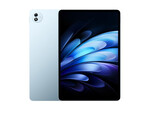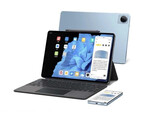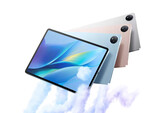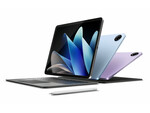Vivo Pad Serie
 Processore: Mediatek Dimensity 9000 Dimensity 9300, Mediatek Dimensity 9000 Dimensity 9400, Qualcomm Snapdragon SD 870
Processore: Mediatek Dimensity 9000 Dimensity 9300, Mediatek Dimensity 9000 Dimensity 9400, Qualcomm Snapdragon SD 870Scheda grafica: ARM Immortalis-G720 MP12, ARM Immortalis-G925 MC12, Qualcomm Adreno 650
Schermo: 11.00 pollici, 11.50 pollici, 13.00 pollici
Peso: 0.489kg, 0.53kg, 0.578kg, 0.679kg
Prezzo: 230, 360, 699 euro
Media dei 1 punteggi (dalle 7 recensioni)
Vivo Pad
Specifiche tecniche
 Notebook: Vivo Pad
Notebook: Vivo PadProcessore: Qualcomm Snapdragon SD 870
Scheda grafica: Qualcomm Adreno 650
Schermo: 11.00 pollici, 16:10, 2560 x 1600 pixels
Peso: 0.489kg
Prezzo: 360 euro
Links:
Price comparison
recensioni esterne
Sorgente: Viettelstore
 VN→IT
VN→ITPratico, disponibile online, Corto, Data: 04/15/2022
Vivo Pad Air
Specifiche tecniche
 Notebook: Vivo Pad Air
Notebook: Vivo Pad AirProcessore: Qualcomm Snapdragon SD 870
Scheda grafica: Qualcomm Adreno 650
Schermo: 11.50 pollici, 3:2, 2800 x 1840 pixels
Peso: 0.53kg
Prezzo: 230 euro
Links:
Price comparison
recensioni esterne
Sorgente: Igeekphone
 EN→IT
EN→ITJudging from the naming, vivo Pad Air seems to be positioned in the mid-range, but after the experience, the 11.5-inch high-spec large screen, four speakers, and even the one-touch mutual transmission function that is only equipped with the flagship tablet gave us a real feeling. It’s not like a mid-range product, but a cost-effective tablet with a lot of stuff. Vivo Pad Air is equipped with an 11.5-inch large screen with a 144Hz high refresh rate and 2.8K resolution. With customized four speakers, you can experience the strongest viewing and visual experience in this price range with a 6.67mm body. experience. In terms of performance, although the Snapdragon 870 is not a flagship chip now, thanks to the fact that it is not limited by size, the performance in the vivo Pad Air is very radical, and it is still more than enough for our daily entertainment and office use.
Singola recensione, disponibile online, Lunghissimo, Data: 08/31/2023
Vivo Pad3 Pro
Specifiche tecniche
 Notebook: Vivo Pad3 Pro
Notebook: Vivo Pad3 ProProcessore: Mediatek Dimensity 9000 Dimensity 9300
Scheda grafica: ARM Immortalis-G720 MP12
Schermo: 13.00 pollici, 3:2, 3096 x 2064 pixels
Peso: 0.679kg
Links:
Price comparison
recensioni esterne
Sorgente: Igeekphone
 EN→IT
EN→ITTo sum up, Vivo Pad 3 Pro shows strong comprehensive strength in terms of experience, with almost no obvious shortcomings. Whether it is entertainment or office needs, it can easily handle it with the support of the powerful performance of Azurite and Dimensity 9300.
Singola recensione, disponibile online, Lunghissimo, Data: 04/05/2024
Vivo Pad 5 Pro
Specifiche tecniche
 Notebook: Vivo Pad 5 Pro
Notebook: Vivo Pad 5 ProProcessore: Mediatek Dimensity 9000 Dimensity 9400
Scheda grafica: ARM Immortalis-G925 MC12
Schermo: 13.00 pollici, 3:2, 3096 x 2064 pixels
Peso: 0.578kg
Prezzo: 699 euro
Links:
Price comparison
Recensioni in
Il Pad 5 Pro di Vivo è un tablet relativamente economico, ma dotato di un SoC di fascia alta e di un display da 13 pollici con un pratico rapporto di aspetto 3:2. Questo lo pone in diretta concorrenza con l'iPad Air 13 - e regge bene il confronto testa a testa. Questo lo pone in diretta concorrenza con l'iPad Air 13 - e regge bene il confronto testa a testa.
recensioni esterne
Sorgente: OI Spice Tech News
 EN→IT
EN→ITThe Vivo Pad 5 Pro, announced on April 21, 2025 and released just days later, arrives as a powerful premium tablet without cellular connectivity. It has a solid build with a glass front and an aluminum back and frame, giving it a clean and sturdy feel despite its large 13-inch footprint. The IPS LCD screen is one of its biggest highlights, offering 1B colors, a smooth 144Hz refresh rate, HDR10 support, and up to 1200 nits peak brightness. With a sharp 2064 × 3096 resolution and a 3:2 aspect ratio, the display feels spacious and crisp for reading, drawing, and entertainment. Stylus support adds more versatility, and the color options, Gray, Blue, White, and Soft Pink, make it easy to pick a style you like. Performance is where the Pad 5 Pro gets even more impressive.
Singola recensione, disponibile online, Cortissimo, Data: 11/26/2025
Sorgente: OI Spice Tech News
 EN→IT
EN→ITThe Vivo Pad 5 Pro, announced on April 21, 2025 and released just days later, arrives as a powerful premium tablet without cellular connectivity. It has a solid build with a glass front and an aluminum back and frame, giving it a clean and sturdy feel despite its large 13-inch footprint. The IPS LCD screen is one of its biggest highlights, offering 1B colors, a smooth 144Hz refresh rate, HDR10 support, and up to 1200 nits peak brightness. With a sharp 2064 × 3096 resolution and a 3:2 aspect ratio, the display feels spacious and crisp for reading, drawing, and entertainment. Stylus support adds more versatility, and the color options, Gray, Blue, White, and Soft Pink, make it easy to pick a style you like. Performance is where the Pad 5 Pro gets even more impressive.
Singola recensione, disponibile online, Cortissimo, Data: 11/26/2025
Sorgente: Vopmart
 EN→IT
EN→ITThe performance of vivo Pad5 Pro can be described as steady and steady. Unlike the exploration of size in previous generations of products, this generation continues the large-screen positioning of the previous generation, and the experience is more mature and stable. With a lighter and thinner body, it is undoubtedly moving towards the direction of "mobile office productivity tools." Combined with the foundation that vivo has laid in terms of interconnection, the vivo Pad5 Pro has undoubtedly become a good portable tool that can temporarily replace a notebook. At the same time, its bold release of performance also complements this large screen with excellent display effects, creating a set of gaming experience that makes us very satisfied - we still need to emphasize again that it is not very suitable for playing games such as "Honor of Kings" and "Peace Elite" that require more grip and button operation.
Singola recensione, disponibile online, Lunghissimo, Data: 05/29/2025
Sorgente: Vopmart
 EN→IT
EN→ITThe performance of vivo Pad5 Pro can be described as steady and steady. Unlike the exploration of size in previous generations of products, this generation continues the large-screen positioning of the previous generation, and the experience is more mature and stable. With a lighter and thinner body, it is undoubtedly moving towards the direction of "mobile office productivity tools." Combined with the foundation that vivo has laid in terms of interconnection, the vivo Pad5 Pro has undoubtedly become a good portable tool that can temporarily replace a notebook. At the same time, its bold release of performance also complements this large screen with excellent display effects, creating a set of gaming experience that makes us very satisfied - we still need to emphasize again that it is not very suitable for playing games such as "Honor of Kings" and "Peace Elite" that require more grip and button operation.
Singola recensione, disponibile online, Lunghissimo, Data: 05/29/2025
Commenti
Vivo:
Ridurre la distanza delle Schede Grafiche per gli utenti che vogliono utilizzare il videogiochi. I nuovi giochi dovrebbero funzionare su queste schede, ma con riduzione dei dettagli e risoluzione mediocre.
Qualcomm Adreno 650:
Chip grafico per smartphones e tablets integrato nel SoC Qualcomm Snapdragon 865. Qualcomm sostiene essere il 25% pi˘ veloce dell'Adreno 640 nel SoC Snapdragon 855 e offre il 50% in pi˘ di unit‡ di calcolo (ALU). Per Android dovrebbe essere una delle schede grafiche pi˘ veloci nel 2020.
ARM Immortalis-G720 MP12: Chip grafico di fascia alta per smartphone con 12 dei 16 core possibili. Basato sulla nuova architettura "5th Gen" (successore di Valhall) che include Variable Rate Shading (VRS) e Ray Racing. Rispetto al G715, dovrebbe essere possibile ottenere prestazioni superiori del 15% a parità di velocità di clock.
ARM Immortalis-G925 MC12: Una GPU integrata veloce per i processori ARM che dispone di ray-tracing hardware, Accuracy Super Resolution e altre tecnologie moderne. Si prevede che sia quasi altrettanto veloce della Qualcomm Adreno 830.
>> Ulteriori informazioni le potete trovare nel nostroConfronto delle schede grafiche e nella nostra Lista dei Benchmark.
Qualcomm Snapdragon:
SD 870:
SoC di fascia alta per smartphone introdotto a metà del 2020 e prodotto a 7 nm da TSMC (migliorato N7P). Integra un Prime Core basato su un'architettura ARM Cortex-A77 con clock fino a 3,2 GHz. Altri tre core più performanti sono anch'essi basati sull'A77 ma con clock fino a 2,42 GHz. Inoltre, sono integrati quattro core per il risparmio energetico che sono basati sull'architettura ARM Cortex-A55 e clock fino a 1,8 GHz.
Mediatek Dimensity 9000:
Dimensity 9300: Dimensity 9300 è un processore di fascia alta con modem 5G integrato. La sezione CPU integra quattro core ARM Cortex-X4 veloci con un massimo di 3,3 GHz e quattro core Cortex-A520 più piccoli con un massimo di 2 GHz.
Dimensity 9400: L'ultimo SoC di punta dell'azienda taiwanese per i telefoni e i tablet premium Android, a partire da novembre 2024. Sfoggia 1 core Cortex-X925 che funziona fino a 3,62 GHz, oltre a 3 core Cortex-X4 (fino a 3,25 GHz) e 4 core Cortex-A720 (fino a 2 GHz). La GPU integrata è Immortalis-G925 MP12; è quasi altrettanto veloce della Qualcomm Adreno 830. C'è anche la NPU MediaTek 890 di 8a generazione con un core "performance" e un core "flessibile", oltre a 5G, Wi-Fi 7, Bluetooth e navigazione satellitare. Il chip offre ~9000 punti Geekbench 6.3 Multi, rendendolo più veloce di qualche punto percentuale rispetto a Apple A18 Pro e di circa il 20% rispetto al Dimensity 9300.
>>Ulteriori informazioni le potete trovare nel nostroConfronto dei processori per portatili.
11.00:
Questa diagonale di schermo è abbastanza grande per i tablets ma piccola per i subnotebooks. Anche alcuni convertibili usano questa dimensione.
I display con dimensioni maggiori consentono risoluzioni più elevate. Quindi, i dettagli come le lettere sono più grandi. D'altro canto, il consumo energetico è inferiore negli schermi con diagonali piccole e su dispositivi più piccoli, più leggeri ed economici.
>> Per scoprire come è la risoluzione del vostro schermo, andate a vedere la nostraLista DPI.
0.489 kg:
0.679 kg:
I tablets più grandi ed i convertibili pesano di più.
84.8%: Il punteggio deve essere considerato medio, in quanto il numero di portatili che hanno ottenuto un punteggio migliore è uguale a quello dei portatili che hanno avuto un punteggio peggiore.
>> Ulteriori informazioni le potete trovare nella nostra Guida all'acquisto di un portatile.



